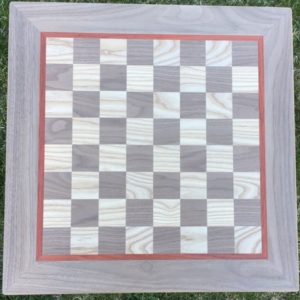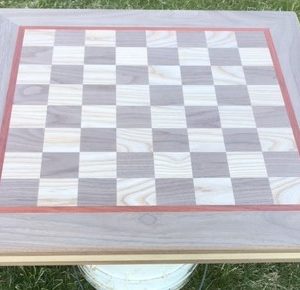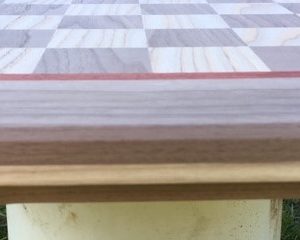Need Help/Advice for What Type of Finish for Chess Board
I am a beginner woodworker and recently made a 24″ x 24″ chess board using walnut, ash and padauk (see pictures…some are darker/lighter due to the lighting). I’ve finished the sanding process (down to 220 grit) and am now ready to apply the finish. I’ve heard or seen a variety of options to finish the chess board and now I am totally confused. Everything from (1) dewaxed shellac followed by varathane, (2) Wipe-On Poly, (3) Diamond Clear Coat water based varathane, to (4) oil based hybrid varnish. Needless to say, as a beginner, I am totally confused. Any suggestions or advice would be greatly appreciated and I realize that there will be varied opinions. The one thing that I would like to maintain is that the chess board not have a glossy finish as, from my understanding looking at official websites, chess players do not like a shine that will “distract” them in certain lighting.



















Replies
To keep the contrast between the different woods ie. to keep the ash as white as possible and padauk red I would use 4 coats of a clear water base varnish. My recipe for this is one coat general finishes sanding sealer and 3 coats general finishes high performance semi gloss sanding 220 with a block or random orbital sander between coats.
“[Deleted]”
Quick question Gulfstar...what do you typically use for a sanding sealer? I have Varathan Premium Diamond Wood Finish Water (Crystal Clear) in both interior and outdoor, in both water-based & oil-based, and in both satin & semi-gloss that I can use after the sanding sealer. Thank you Gulfstar.
https://generalfinishes.com/wood-finishes-retail/water-based-topcoats-and-sanding-sealer/enduro-water-based-sanding-sealer
Have you thought about going old school? Tung oil is simple, fast, low glare, cheap, easy to apply, no VOC, ideal for a beginner and spot repairable should you ever need to do so.
Try the Festool Surfix Heavy Duty Oil. Easy to apply, durable and a beautiful matte finish. A sponge, a scotch-brite pad and a soft rag are all you need
I'll second Gulfstar's response. Water-borne finishes (from good suppliers) will dry crystal clear, and preserve the wood contrast. The one caveat that I'll offer is the walnut... unlike the Ash and Paduak, Walnut has an open-grain, and you'll need several coats of sanding sealer to begin filling-in the Walnut grain ahead of applying finishing coats to the overall piece. I use Zinsser SealCoat sanding sealer (excellent product), and I'll assume the Varathan is of similar quality - I don't know this product. Regarding sanding, I would take the grit to 400 (a bit lost on the Walnut, but the Ash and Paduak should shine). You need to get the sanding sealer underneath the water-borne finishes (applied first, and second, and third if necessary), so that the top coat's water-ness doesn't get to the wood, itself.
Well...for better or worse I am trying Osmo PolyX Oil/Hard Wax in Satin. I looked and looked online and there were so many different options and I came across Matt Estlea's video on Osmo PolyX (https://www.youtube.com/watch?v=LHmZox9WWSE) as well as Peter Parfitt's video on Osmo applications (https://www.youtube.com/watch?v=z9Rp65DAarE). I first heard of Osmo PolyX from Joshua Escolas on the Facebook group "Woodworkers Tips & Tricks" I just applied the 1st coat this morning and it looks great. The one thing that swayed me on Osmo was that it's repairable. If ever the board needs repairs then I don't have to sand it all down. I can just lightly sand the damaged area and reapply Osmo PolyX. I guess time will tell if this was a good choice. I'll post a picture of the board after the 1st application.
Any type of wipe on would be a good choice.
Spraying would also be an excellent choice.
A rattle can will do the job.
Lacquer would be a good choice, be sure to use precautions if you do.
This forum post is now archived. Commenting has been disabled